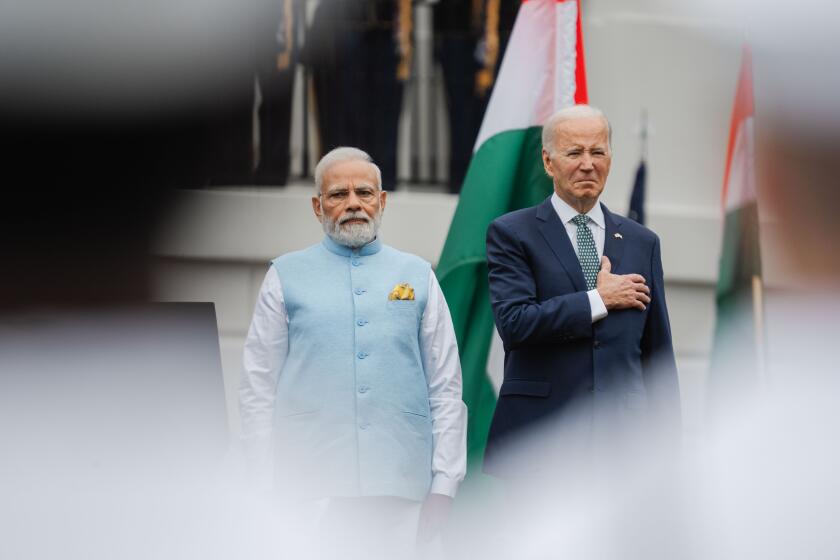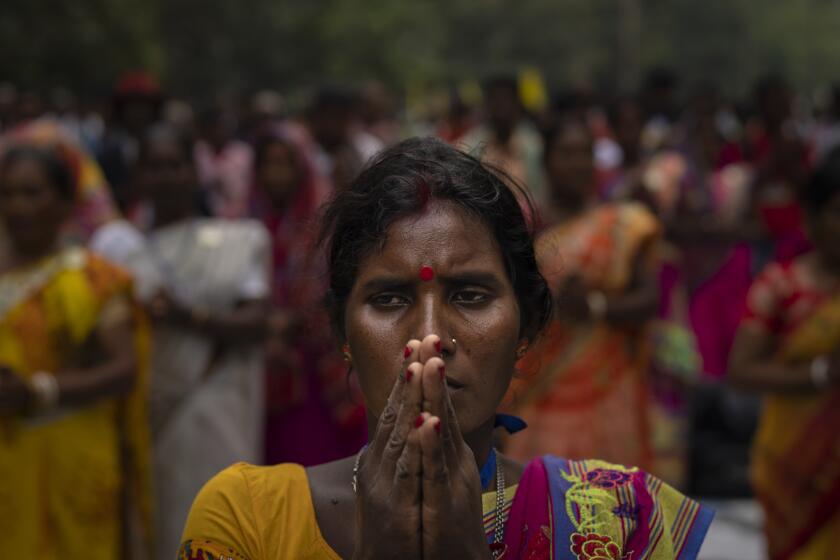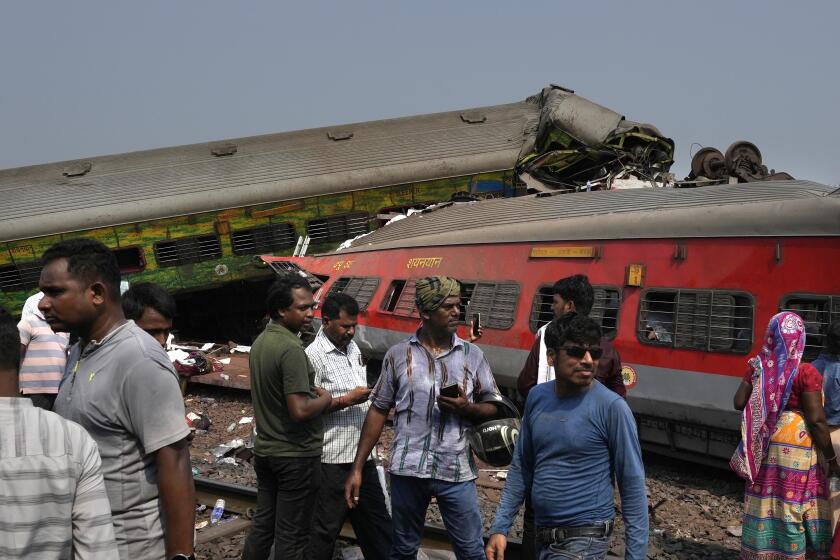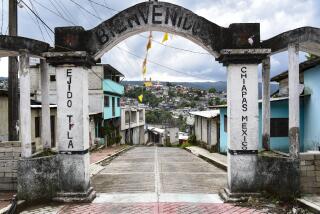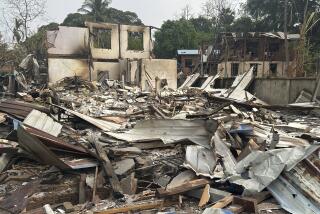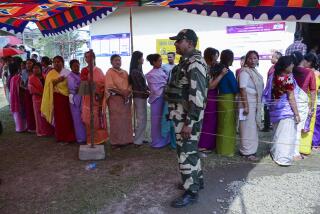A remote Indian region teeters on the brink of civil war after armed mobs rampage
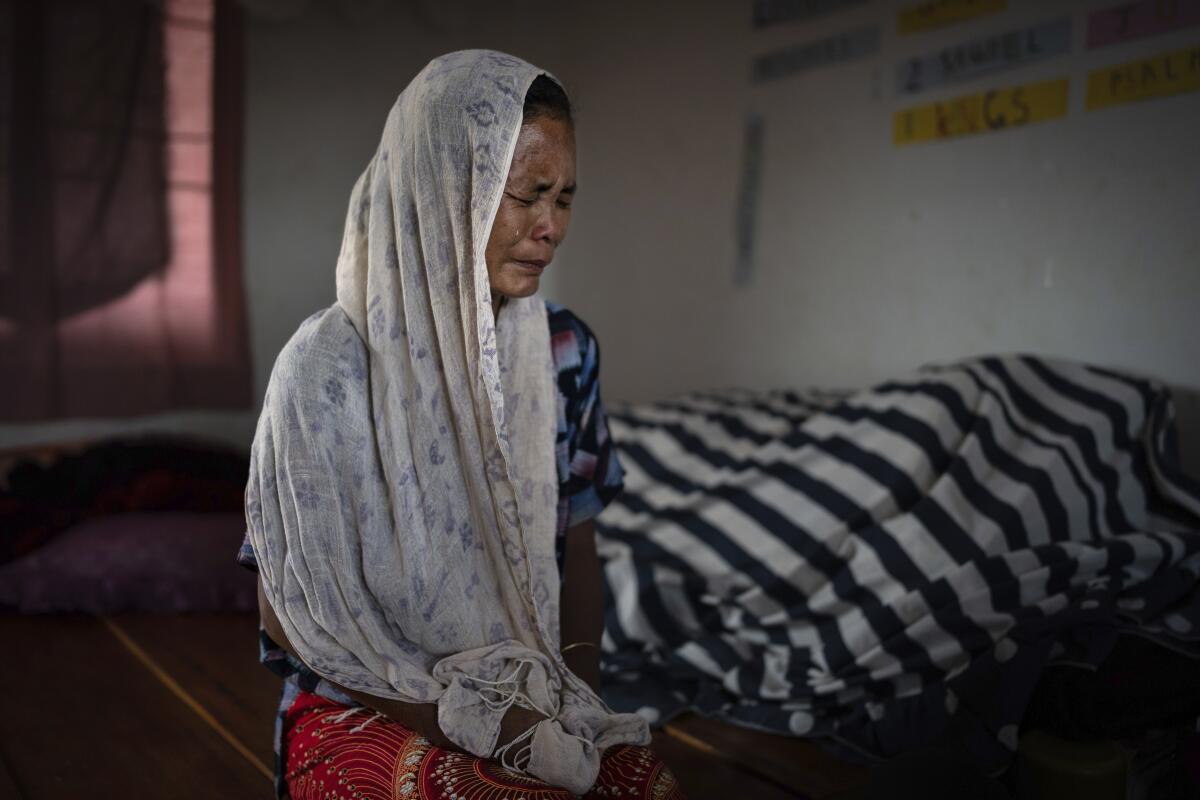
- Share via
KANGVAI, India — Zuan Vaiphei is armed and prepared to kill. He is also ready to die.
Vaiphei spends most of his days behind the sandbag walls of a makeshift bunker, his fingers resting on the trigger of a 12-gauge shotgun. Some 1,000 yards ahead of him, between a field of tall green grass and wildflowers, is the enemy, peering from parapets of similar sandbag fortifications, armed and ready.
“The only thing that crosses our mind is: Will they approach us — will they come and kill us? So, if they happen to come with weapons, we have to forget everything and protect ourselves,” the 32-year-old says, his voice barely audible amid an ear-splitting drone of cicadas in Kangvai village, along the foothills of India’s remote northeastern Manipur state.
Dozens of such makeshift fortifications divide Manipur into two ethnic zones: one of people from hill tribes and the other of people from the plains below.
Two months ago, Vaiphei was teaching economics when the simmering tensions between the two communities exploded in a a bloodletting so horrific that the thousands of Indian troops sent to quell the unrest remain near-paralyzed by it.
Ethnic clashes between different groups have occasionally erupted in the past, mostly pitting the minority Christian Kukis against mostly Hindu Meiteis, who are a narrow majority in the state. But no one was prepared for the killings, arson and a rampage of hate that followed in May, after Meiteis demanded a special status that would allow them to buy land in the hills populated by Kukis and other tribal groups, as well as a share of government jobs.
Rhetoric about democracy papered over policies advanced by Narendra Modi and his party that discriminate against India’s Muslims and limit freedom of speech and the press.
Witnesses interviewed by the Associated Press described how angry mobs and armed gangs swept into villages and towns, burning down houses, massacring civilians and driving tens of thousands from their homes. More than 50,000 people have fled to packed relief camps. Those who fought back were killed, sometimes bludgeoned to death or beheaded, and the injured tossed into raging fires, according to witnesses and others with first-hand knowledge of the events.
The deadly clashes, which have left at least 120 dead by the authorities’ conservative estimates, persist despite the army’s presence. Wide swaths have turned into ghost towns, scorched by fire so fierce that it left tin roofs melted and twisted.
“It is as close to civil war as any state in independent India has ever been,” said Sushant Singh, a senior fellow at the Center for Policy Research in India and an army veteran.
The unrest has been met with nearly two months of silence from Prime Minister Narendra Modi, whose Hindu nationalist Bharatiya Janata Party rules Manipur. Modi’s powerful home minister, Amit Shah, visited the state in May and tried to make peace between the two sides. Since then, state lawmakers — many of whom escaped after their homes were torched by mobs — have huddled in New Delhi to try to find a solution.
India will soon eclipse China to become the world’s most populous country, and its economy is among the fastest-growing.
The state government insists that Manipur is returning to normal. On June 25, Chief Minister N. Biren Singh said the government and armed forces had been “able to control the violence to a great extent in the past week.” However, Singh’s visit Sunday to a flashpoint coincided with fresh clashes that left three people dead, officials said.
Meiteis have long blamed the minority Kukis for the state’s rampant drug problems and accused them of harboring migrants from Myanmar. The state government administration, mostly made up of Meiteis, also appears to be coming down heavily on Kukis after Singh alleged that some of those involved in the latest clashes were “terrorists.”
Trouble reached A. Ramesh Singh’s home May 4 in Phayeng, a predominantly Meitei village some 10 miles from the state capital, Imphal.
The previous day, Singh had kept a vigil outside his village, whose more than 200 residents were expecting mobs of Kukis to descend from an adjacent hill. A former soldier, Singh carried a licensed gun with him, his son, Robert Singh, said.
In India, believers of Sarna Dharma, an ancient Indigenous faith system centered on reverence for nature, are seeking formal government recognition.
The night of the raid, Singh fired shots, some in the air and some at the mobs, but was hit in his leg. Wounded and unable to walk, he watched his village being ransacked, before he was abducted with four other people and dragged up the hills, his son said.
The next day, Robert was told his father’s body was found in a grove. He had been shot in the head.
The anguish of victims also resonates quietly through hundreds of relief camps where displaced Kukis — who have suffered the most deaths and destruction of homes and churches — are taking shelter.
Kim Neineng, 43, and her husband had enjoyed years of peace in Lailampat village. He farmed the fields. She sold the produce in the market.
Breaking News
Get breaking news, investigations, analysis and more signature journalism from the Los Angeles Times in your inbox.
You may occasionally receive promotional content from the Los Angeles Times.
On the afternoon of May 5, Neineng went outside her house to check on a noise. Out of breath, she rushed inside and told her husband what she had seen: A Meitei mob, many of them armed, had descended on their village, screaming and hurling abuse.
Neineng’s husband knew what it meant. He asked her to escape with their four children and not look back, promising he would take care of the cattle and their home. She quickly packed her belongings and ran to a nearby relief camp.
A day later, more of her neighbors reached the shelter and told Neineng what had happened to her husband.
When the mob reached their house, he had tried to reason with them, but they wouldn’t listen. Soon, they started beating him with iron bars. More armed men arrived and chopped off his legs. Then they picked him up and tossed him in the raging fire that had already engulfed his home.
The massive derailment involving two passenger trains is a stark reminder of safety issues that continue to challenge the vast railway system that transports nearly 22 million passengers each day.
Neighbors found his charred body on the scorched floor.
“They tortured and treated him like an animal, without any humanity. When I think of his last moments, I can’t comprehend what he must have felt,” Neineng said, barely choking out the words.
More to Read
Sign up for Essential California
The most important California stories and recommendations in your inbox every morning.
You may occasionally receive promotional content from the Los Angeles Times.
